Final report for FW19-349
Project Information
Performance of novel clonal cacao accessions in Hawaii under sustainable farming conditions
Despite strong demand for cocoa and chocolate of Hawaii origin, cocoa production in Hawaii remains limited to several hundred metric tons produced on a small number of farms (approximately 60 across the different islands). There is potential for growth and cocoa, much like coffee production, is a potential high-value economic opportunity for farmers in the State. One of the limitations of cocoa production in Hawaii is the lack of proven, productive planting materials with good resistance to disease. Farmers usually use trees derived from seed produced on their own farms, without pollination control. The result is unpredictable: 70-80% of the cocoa is typically produced from 20-30% of the trees, with an undesirable heterogeneity of growth habits. More sophisticated production systems rely on clones that have been selected for their productivity, resilience and for cocoa quality. The benefit is higher, more consistent production and higher uniformity in the plantation, resulting in more cost-effective farm management.
In this project, we propose to test new clones on a 3-acre plot near Ninole. These clones have recently been introduced by USDA, after years of selection from genetically diverse populations, to combine yield, resistance to disease and cocoa quality. Ten clones will be compared with locally obtained seedlings. In order to guarantee the sustainability of the production system, our objective will be to identify a group of 3-4 complementary productive clones, which, used together, will maintain genetic diversity in the orchard, while offering diverse cocoa quality options. The clones will be grown using sustainable agronomic practices designed to maintain soil fertility and limit waste.
The work will be supervised by USDA and the trial will be used to build awareness in the farming community through a series of information and training sessions.
- Establish an experimental orchard based on clonal cocoa. Our aim is to develop a cost-effective protocol for the development of grafted clonal materials and control seedlings. This includes comparing direct planting with nursery germination, developing cost effective protection of plantlets against insects, fending off weed competition. Success measures: rate of survival of seedlings and grafted plantlets, growth rate, plant replacement within a year
- Compare the performance of clones and seedlings. This will be measured by their rate of development, morphology, flowering time, fruit set, pod index, pod and bean yields, bean size, production per tree, % productive trees, disease tolerance.
- Develop a sustainable agronomic system to optimize the production of clones and seed-derived trees and minimize the cost of production. Different pruning regimes will be tested for clones and seed-derived controls. We will compare different ground cover crops and their efficiency vs herbicide treatments. Success measures, for pruning: productivity, disease incidence and intervention time; for weed control: ground cover index and speed, weed incidence.
- Raise awareness of the farming community on clonal cocoa management and on new clonal materials introduced by USDA. This will be done through farm visits and measured through farmer surveys
|
Objectives |
Activities |
Main deliverables |
Timing |
|
1. Establish an experimental clonal cocoa orchard |
Evaluation of direct seeding |
Germination rate and survival rate |
Month 3 |
|
Monitoring survival of plantlets |
Survival rate |
Months 3, 6 and 12 |
|
|
2. Compare the performance of clones and seedlings |
Plant development |
Plant/crown height, trunk diameter |
Every 6 months for 3 years |
|
Morphology |
Canopy diameter |
||
|
Productivity |
Flowering, productivity, bean size |
||
|
Disease |
Black Pod infection |
||
|
Statistical analysis |
genetic and environmental effects |
End of years 2 and 3 |
|
|
3. Develop a sustainable agronomic system |
Pruning |
Effect of pruning on productivity and disease |
Every 6 months in years 2 and 3 |
|
Ground cover |
Selection |
Month 6 |
|
|
Growth rate and weed prevention effect |
Months 7, 10 and 12 |
||
|
4. Raise awareness on sustainable clonal cocoa production |
Field days |
Field days and surveys |
Mid year, on years 2 and 3 |
|
Survey results |
1 month following field visits |
||
|
Local event with East Hawaii Cocoa Association |
Event planned |
End of year 2 |
|
|
Local event and surveys |
End of year 3 |
||
|
Survey results and small article |
1 month after local event |
||
|
Presentation by USDA at international event |
Presentation prepared |
End of year 3 |
|
|
Results presented |
tbd |
||
|
Evaluation and producer adoption |
Follow up survey |
Survey prepared |
2 months after last field visit |
|
Survey results |
3 months after |
Cooperators
- - Technical Advisor - Producer
- - Technical Advisor - Producer
- - Producer
- - Technical Advisor (Researcher)
- - Technical Advisor (Researcher)
- - Technical Advisor - Producer
- - Technical Advisor - Producer
- - Technical Advisor - Producer
- - Technical Advisor - Producer
Research
- Establish an experimental orchard based on clonal cocoa
Materials
Clones: 10 clones will be tested: 8 clones selected by USDA in Ecuador and 2 locally selected clones. The selection criteria for these clones were: pod count, pod index, bean size, resistance to fungal disease (Osman Gutierrez, Cocoa Program Lead, USDA ARS, Miami FL, personal communication).
Seed-derived materials: pods will be locally sourced from experimented cocoa farmers, using trees they recommend.
Trial design:
1-1.5 acres of clonal cocoa will be planted on the upper part of our farm. Another 1.5-2 acres of seed-derived cocoa trees will be planted as controls. The trees will be arranged in sets of 2 rows of plants separated by 10’ wide alleys. Cocoa trees within rows will be planted 6’ apart and the two rows will be planted in a staggered fashion, in order to facilitate access to the trees from both sides, for pruning and harvesting purposes. The larger alleys should allow for a small tractor to bring materials and haul away pruned branches or harvested pods. The total number of plants will be approximately 750/acre.
In order to facilitate harvest and traceability, while controlling for environmental differences, the clones will be arranged in 2 blocks of 35-50 trees, alongside 3 blocks of 50 control trees. The blocks will be randomly distributed and tagged with a unique identifier.
Development of the cocoa plantlets:
Two types of plantlets will be used for our trial: grafted plantlets for clones and seedlings for seed-derived trees. Grafted plantlets will be provided by USDA: they will have been produced by micro-grafting (grafting onto hypocotyls), on local seedlings used as rootstocks.
Seedlings will be produced in 2 ways: 1) by direct seeding in the field or 2) in the nursery, after growing them for 4-5 months in 4” pots or tubes under shade. Direct seeding will be done as recommended(Cacao 101: Seed to Pod. H.C. “Skip” Bittenbender - presentation, personal communication)), by planting 2-3 seed and ultimately keeping only the most vigorous seedling. Nursery grown seedlings or grafted plants will be transplanted into the field at 4-6 leaf stage, taking care that no part of the root is twisted.
Protection of the emerging plantlet
In Hawaii, cacao plantlets are known to be susceptible to rosebush beetles and pigs. The planted area will be fenced to keep pigs out. To protect plantlets against insects, they will be placed under a cage adapted from Bittenbender and Caraballo Ferrer (Evaluation of field cage design for seed planted cacao in Hawaii. H.C. “Skip” Bittenbender and Jeffrey Caraballo Ferrer - poster, personal communication). The cages will be removed following seedling establishment. Several alternative designs are currently being tested and the most effective and least costly solution will be retained.
Weed control (see below)
2 different types of ground cover crops will be planted and compared: a legume, Arachis pintoi (perennial peanut) and a grass, Paspalum viginatum (http://turfgrass.ctahr.hawaii.edu/downloads/seashore%20paspalum.pdf).
Collection of data and parameters measured:
We will keep track of a sample of seed and seedling planted and follow their fate over time (about 200 trees per treatment). Germination and seedling survival rates will be calculated after direct seeding. Similarly, we will estimate the survival rate of seedling and grafted plants at 3, 6 and 12 months, as well as the replanting rate. Development of the plantlets will be evaluated as described below.
- Compare the performance of clones and seedlings.
The following characteristics of the plants will be measured every 6 months for 3 years:
- Development rate: height, trunk diameter and crown height (for seedlings) - up to moderate pruning limit set below
- Morphology: canopy diameter – up to moderate pruning limit set below
- Production: flowering time, number of pods, number of beans per pod (sample of 50 random pods per variety), bean size, average dry bean yield per repetition
- Disease: % Black Pod infected pods
- Other: signs of insect damage
Statistical analysis will be performed to evaluate the effect of variety and environment on these different characteristics
- Develop a sustainable agronomic system to optimize the production of clones and seed-derived trees and minimize the cost of production.
Pruning
Two pruning regimes will be tested for clones and seed-derived controls:
- Severe pruning: plants topped at 7’, diameter of the plants restricted to 5’
- Moderate pruning: plants topped at 9’, diameter of the plants limited to 6’
Suckers will be removed from seed-grown trees, in order to avoid the development of additional crowns.
This trial will be done on plants that are not included in the variety trial, using 1-2 clones (according to material availability) and control trees. 2 repetitions of 10 trees per treatment will be used at a minimum.
Pod count, pod index and disease incidence willberecorded
Cover crops
We will compare 2 different ground cover crops: a legume, Arachis pintoiand a grass, Paspaulum viginatum, and will compare their efficiency to an herbicide treatment. After establishment of the cocoa, the relative effect of ground covers will be tested on 2 blocks each, in areas grown in control seedlings - taking care of not interfering with the variety trial, which will be planted with only one cover crop. 2 additional blocks will be left free of ground cover and treated with herbicides.
The cover crops will be compared for vigor and area covered over time (sqft after 1, 3 and 6 months) and for their effectiveness in keeping weeds out (sampling for presence of weeds over several 10 sqft areas).
- Raise awareness of the farming community on clonal cocoa management and on new clonal materials introduced by USDA (see educational outreach below).
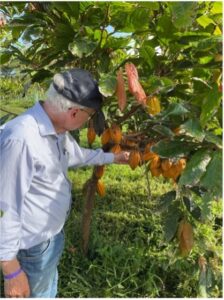
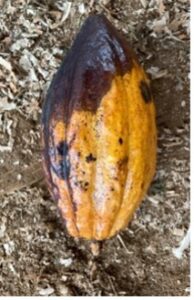
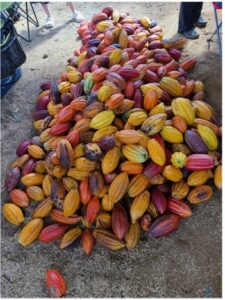
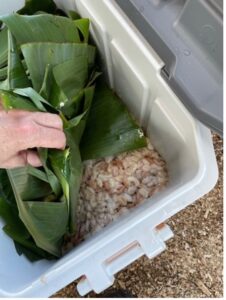
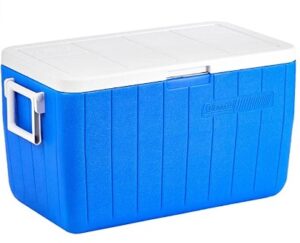
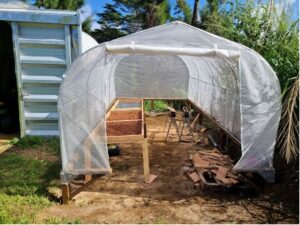
State of the plantation
The oldest part of the plantation (2019 planting) entered maturity in the last year. The area planted in 2020 was still immature at the time of this report.
It was the first year where we had a sizable harvest of cocoa beans and could estimate the proportion of productive trees on the farm. In order to evaluate this, we performed a survey in March 2022 based on a representative sample of 66 trees:
- Tree development
- 76% have pods
- 6% have more than ten pods (Fig. 1)
- Only 62% were still flowering at the time of the survey
- average jorquette height: 3.85 feet
- Mortality: 5.5% were considered to need replanting
Fig.1: Highly productive tree
Genetics
Unfortunately the clones that were going to be tested were never delivered by USDA so the variety trial that was initially envisioned could not take place.
Agronomy
- Weed control
Weeding continued to be a major concern, due to the high levels of rainfall on our wet side of the island. As described in previous reports, we have developed a sustainable way to control weeds without the use of herbicides: weeding is done only by mowing.
This results in developing a grassy ground cover throughout the plantation that keeps other weeds down and protects against soil erosion
- Control of stumps
Our plantation was originally a sparse secondary forest, composed of invasive trees (African tulip and Albizia). After clearing, stumps were left that kept producing shoots interfering with cocoa cultivation. We were able to reduce regrowth by spreading thick black tarp on some of these areas, thereby limiting the use of herbicides.
- Fertilization and soil pH correction (see table 1)
All trees were fertilized every six months with 100 g of 16:16:16 applied around the perimeter of the tree.
As the soil is slightly acidic, all tree perimeters were limed every six months (3 months offset from fertilization ) with 150 g of Ag10 Dolomite.
- Pest and disease mitigation (see table 1)
Chinese Beetles remained the major pest issue, causing in some cases extensive leaf damage. We were however able to control infestations by applying soil drenches of imidacloprid. This was only done before pods started maturing on the trees (to prevent systemic movement into the mature beans): all the trees were treated with imidacloprid on 9/11/21, which was the only treatment in 2021. We used 100mg of imidacloprid in 5 oz of water. The treatment was effective and we did not re-apply since.
We noticed symptoms that were reminiscent of the Black Pod fungal disease (Phytophtora palmivora). Symptoms remained generally limited and only present on a handful of trees (Fig. 2)
Fig. 2: pod presenting symptoms similar to those of P. palmivora infected pods
Table 1: treatment schedule
|
Date |
Lot |
Fertilizer (N.P.K.) Insecticide |
Amount/tree amt |
Lime Amt |
Lime type |
|
3/10/21 |
Lower |
16.16.16 |
100g |
||
|
3/10/21 |
Upper |
150 g |
Ag 10 dolomite |
||
|
6/24/21 |
Lower |
150 g |
Ag 10 Dolomite |
||
|
6/24/21 |
Upper |
16.16.16 |
100 g |
||
|
9/11/21 |
Lower |
imidacloprid |
5oz p tree (450ml/Gal) |
||
|
9/11/21 |
Upper |
imidacloprid |
5oz p tree (450ml/Gal) |
||
|
10/1 |
Upper |
16.16.16 |
100g |
||
|
10/1 |
Lower |
150g |
Ag 10 Dolomite |
||
|
11/3 |
Upper |
20.20.20 (foliar) |
300ml/tree (113g per gal) |
||
|
2/1 |
Upper |
150g |
Ag 10 Dolomite |
||
|
2/1 |
Lower |
16.16.16 |
100g |
Harvesting
- Volumes
There have only been 2 complete harvests so far. One in December 2021 (800 pods, 180 pounds wet cocoa, 72 pounds dry cocoa) and one in March (575 pods, 153 pounds wet, 61 pounds dry). A partial harvest is underway (around 150 pounds wet), corresponding to about half of the pods available; the other half is planned in June.
All the pods were harvested on trees in the upper lot that were planted in 2019 – representing around half of the trees in the plantation. None of the trees planted in the lower lot were ready for harvest.
- Pod and bean characteristics
- Number of beans per pod =41.7
- Wet Weight per bean = 2.5g
- Wet weight of beans per pod 104.25 g
- Dry weight per bean 1.01g
- Each kg of wet beans yields about 404 g of dry beans.
Fig. 3: Pods after harvest
Fermentation and drying
- Background
Fermentation is the process of producing individualized beans that have developed structural and flavor characteristics making them suitable for downstream processing and consumption. It is an essential step in post-harvest processing, which is a complex, natural process involving a diversity of microbes. The primary objectives of fermentation are:
- To eliminate the pulp (whitish, sticky, sour sweet)
- To develop flavor precursors
- To kill and preserve the beans (together with drying)
- To yield commercial, fermented beans for further transformation into chocolate or associated products
Fermentation consists of 2 major phases:
- An anaerobic phase, during which sugars are fermented to ethanol by yeasts. Lactic acid bacteria are also active at this stage, which produce lactic acid and other metabolites
- An aerobic phase, during which ethanol is fermented to acetic acid through the action of Acetobacter type bacteria
The two phases are necessary to generate the flavor precursors in the bean. During the second phase, a combination of high temperatures and acidity kill the beans, which releases and activates enzymes that are necessary for the generation of these precursors.
To achieve successful fermentation, it is necessary that cocoa beans are under conditions that allow them to undergo these successive phases. In addition, beans should be handled in a way that does not give opportunities for off-flavors to develop. These off-flavors can result from the use of spoiled beans or un/overripe beans, poor fermentation conditions affecting microbial development, contamination during fermentation and/or drying leading to the development of molds.
Drying is also very important for flavor development. Conditions need to allow effective drying while allowing undesirable volatiles, in particular acetic acid, to evaporate.
- Fermentation conditions
Our challenge, on this first year of harvest, has been to develop a fermentation system allowing us to produce the highest possible quality of cocoa from relatively small harvest volumes. This can be an issue in Hawaii, especially on the East side of the main island, where rainfall is high, day temperatures can be moderate and night temperatures can fall down to 18-20C. Low fermentation temperatures can result in incomplete fermentation and rain can compromise drying if precautions are not taken to condition fermenting/drying beans appropriately.
- Development of a fermentation method
We had to find containment for our small bean volumes, which would allow a relatively small mass of wet beans to accumulate sufficient heat during fermentation. We tested different fermentation containments (see below) but ultimately turned to isothermic coolers (for food and beverages), to provide insulation from decreasing temperatures at night time.
In order to accelerate fermentation and give cocoa less opportunity to develop molds, we also tested the priming of fermentation with cultured yeasts (Forte).
Each fermentation was monitored with thermometers to ensure that temperature progression was satisfactory.
A first experiment was conducted to test different types of containment:
- 5 gallon bucket at ambient temperature
- Cooler (12 gal, 45 l)
- 12x12x12 wooden box
All containment was perforated at the base to allow for drainage of juices
The containers were either covered with a lid of with banana leaves (Fig. 4). Containers covered with banana leaves developed molds and banana leaves were not used after that point.
Fig. 4: Banana leaves used to cover small fermentation batch
Temperature rose slowly and reached 30C at the earliest after 5d. This was imputed to the low volume of beans in each containment. Temperature rose fastest in the cooler, which was selected as the containment of choice for these early fermentations. Still, fermentation lasted a minimum of 8 days (in the cooler), which exceeds the target of 5-6 days. Fermentation took longest in the 5-gallon bucket (12 days), whereas it took 10 days in the box
Table 2: evolution of fermentation parameters
|
Ambient day temperatures (oC) |
Cooler bean mass temperature (oC) |
Bucket bean mass temp (oC) |
Box bean mass temperature (oC) |
|
5 21.5 |
30 |
25.9 |
27.3 |
|
6 23.2 |
41 |
26.2 |
27.3 |
|
7 24.2 |
43 |
27.1 |
32.4 |
|
8 (Sat) 27.6 |
44.3 (fermentation stopped) |
27.4 |
32.5 |
|
9 |
44.7 |
||
|
10 |
43.3 (fermentation stopped) |
||
|
11 |
34.4 |
||
|
12 |
43.5 (fermentation stopped) |
A second experiment concentrated on fermentation in chest coolers and inoculation with yeast:
- Wet beans were equally distributed between two 55 quart chest coolers (Fig. 5) that were perforated at the base and slightly tilted to allow juice to drain.
- One chest (#1) was stirred by hand and a thermometer placed inside. The other chest (#2) was seeded with 75 g of Forte yeast in 500 ml of water, stirred by hand then closed with a thermometer inside.
On the second day of fermentation, fermentation #1 remained at 23C, while fermentation #2 already reached a temperature of 29.8C with bubbling and the development of a smell of yeast and alcohol.
On the third day, fermentation #1 remained at 23C with a layer of mold growth developing on the surface. Fermentation #2 remained at 30C (probe in middle of batch) with no obvious growth of mold.
Fermentation was eventually stopped at 5 or 6 days after a phase of bean mixing.
The conclusion was that yeast promoted vigorous anaerobic fermentation, shortened fermentation and reduced mold growth, presumably due to the competition of yeast.
Fig. 5: 12 gallon cooler used in fermentation experiments
Overall conclusions of fermentation experiments:
- Fermentation in small buckets or boxes does not reach sufficient temperatures, presumably due to poor insulation and small bean volumes
- The use of banana leaves promotes mold development at the surface and is to be avoided
- Fermentation in isothermic (cooler) boxes allows for stronger increases in temperature
- Yeast inoculation accelerates fermentation and the initial increase in temperature. Mold growth appears to also be repressed
Drying
To protect drying beans, we constructed a wooden drying platform, which was placed under a transparent plastic cover, leaving openings at each end for air circulation (Fig. 6)
The beans were spread for 1-2 weeks with daily mixing. Drying was performed until moisture reached 7-8%
Fig. 6: Covered area for bean drying (solar drier)
Research Outcomes
Education and Outreach
Participated in monthly meetings of the East Hawaii Cacao Association (via zoom).
Set up a collaboration with a neighboring farm to study the Chinese rose beetle infestation
Reached out to HARC to explore possible collaboration
Participation Summary:
Educational outreach will be organized in 3 ways: field days, presentation at local and international events (through USDA)
Field days
Two field days will be organized, one in year 2 and one in year 3 of the trial. 20-30 farmers will be invited on each occasion. The farmers will be identified on the basis of a recent cocoa survey (2018 Hawaii Cacao Survey: January to December 2017. HC ‘Skip’ Bittenbender - presentation, personal communication) and through the local cocoa associations. They will be picked to be as representative as possible of the cocoa farming community in Hawaii. The farmers will be contacted, with the help of the associations, through a mailing describing the objectives of the field day, the agenda, who will be presenting and who will be in attendance.
The field days will start with a general presentation of the trials, preceding a 2-hour field visit. The different trials will be presented to the farmers by USDA representatives, seconded by representatives of Ninole Cacao LLC. After the field visit, a question and answer session will be held and a survey will be handed out to participants.
The survey will include a mix of multiple choice and open questions, covering the following topics:
- Establishment of clonal and seedling plantations: propagation methods, protection of the plantlets, weed control (main focus of field day 1)
- Performance of individual clones, comparison of clones to traditional seed-derived varieties (focus of field day 2)
- Agronomic treatments: ground cover and pruning regimes (field days 1 and 2)
- Cost and sustainability of the different production models (focus of field day 2)
It will be built following the recommendations of Western SARE. Several questions will be added on the format of the field day and survey, leaving room for farmer suggestions on possible improvements. A satisfaction score will be recorded on the field day, the quality and clarity of the presentations, and on the survey itself
A general ranking of the clones and agronomic practices will be inferred from the farmer responses. Farmers’ comments will be organized and synthesized to help improve the quality and impact of the field days from year 1 to year 2.
A small survey report will summarize the findings
Presentation at local event
A presentation of the trial will be made locally at the end of year 3, in front of the East Hawaii Cocoa Association. This 2nd event will be organized with the association, in coordination with county authorities and USDA. The event will start with a social gathering to allow for introductions and will be followed by a formal presentation made by representatives of USDA and Ninole Cacao on trial results and field day outcomes. At the end of the presentation, a question and answer session will be organized.
Highlights of the event will be recorded in a ½ to 1-page article, to be published by the association. The attendants will be asked to fill a survey on the quality of the event, the clarity of the presentation and on the likely impact the event will have on their own practices.
Presentation at an international event
The results of the trials will be shared with lead cocoa scientists within USDA. These scientists will be requested to share these findings in international public or industry conferences or workshops, in which the evaluation of USDA clones or cocoa research in Hawaii is presented. For this purpose, a summary presentation (1-3 slides) of the purpose and main results of the trial will be prepared and shared with selected USDA scientists during year 3.
Update March 2021
Due to COVID restriction, educational and outreach activities have been strongly restricted in 2020
Update May 2022
We were again limited in our capacity to organize outreach activities in 2021. Unfortunately, because clonal materials were never delivered, we did not have the opportunities to leverage them for educational/outreach purposes.
We intend to organize a communication with the East Hawaii Cocoa Farmer association on our findings on the following topics:
- successful use of tubes instead of cages at planting and associated cost savings
- Weed and stump control
- Fermentation containment, artificial inoculations
- Drying setup
- Results of sensory analyses